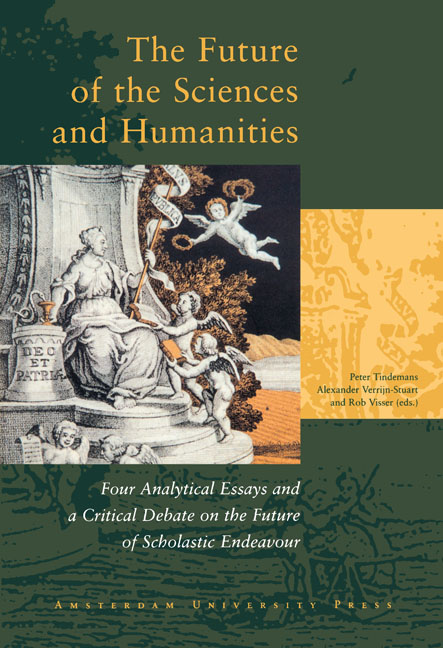 The Future of the Sciences and Humanities
The Future of the Sciences and Humanities Book contents
- Frontmatter
- Preface
- Contents
- 1 The Sciences and Arts Debate A review and some conclusions
- 2 Historical and Structural Approaches in the Natural and Human Sciences .
- The Role of Laws and Contingency in History
- 3 Science and Society in Flux
- Does A New Kind of Science Require a New Kind of Scholar or a New Kind of University?
- 4 Science for the 21st Century
- Redrawing Disciplinar Boundaries – but to What Degree?
- 5 Science and Democracy
- Science and Democracy: a Difficult Relationship: ‘An enlightened and elitist essay on an unresolvable problem’
- 6 Epilogue
- 7 Appendix
7 - Appendix
Published online by Cambridge University Press: 03 February 2021
- Frontmatter
- Preface
- Contents
- 1 The Sciences and Arts Debate A review and some conclusions
- 2 Historical and Structural Approaches in the Natural and Human Sciences .
- The Role of Laws and Contingency in History
- 3 Science and Society in Flux
- Does A New Kind of Science Require a New Kind of Scholar or a New Kind of University?
- 4 Science for the 21st Century
- Redrawing Disciplinar Boundaries – but to What Degree?
- 5 Science and Democracy
- Science and Democracy: a Difficult Relationship: ‘An enlightened and elitist essay on an unresolvable problem’
- 6 Epilogue
- 7 Appendix
Summary
THE HOLLAND SOCIETY OF ARTS AND SCIENCES
The “Hollandsche Maatschappij der Wetenschappen” (Holland Society of Arts and Sciences) was established in 1752 by seven distinguished burghers of the city of Haarlem, in the then Republic of the United Provinces of the Netherlands, in order “to promote science”. It is the oldest learned society in the country today and is constituted as a dual body comprising approximately 275 “science promoters” (known as “directors”) and about 325 active scholars (known as “members”), drawn from the natural sciences, the humanities and the social sciences. It has always maintained relationships with scholars in other countries (the “foreign members”, currently numbering about 25).
Thanks to its unusual structure, the Society can act as an effective meeting place for leading persons from within and outside academia. It is also in an unique position to provide independent judgement in many fields and does this by serving in the review process for a number of prestigious awards and fellowships.
Since 1841, the Holland Society has resided in a majestic town house, designed and built in 1794 by the municipal architect of Amsterdam, Abraham van der Hart (1747-1820), for the young and immensely rich Cornelia Catharina Hodshon (1768-1829), daughter of a linen merchant of English descent. Information about the Society is available by access to its website “www.hollmij.nl”, including a virtual visit to the Hodshon House.
Apart from serving as a forum for the dissemination and discussion of scientific discoveries, the Society set out to promote the sciences and arts by prize competitions. In the spirit of the mid-18th century, the themes often concerned application of (useful) knowledge rather than challenges to broaden theoretical insight. Over a period of 154 years, 1206 competition questions were set, but only 169 responses were ever considered worthy of the gold medal of honour. In fact, after the rush of the early years, the interest in prize competitions waned. Other vehicles for promoting the arts and sciences presented themselves. First, the universities took over the role of the learned societies as centres of research and dissemination of knowledge. Next, specialized journals replaced the societies’ transactions. Finally, research began being sponsored and supervised by national councils and publicly funded academies.
- Type
- Chapter
- Information
- The Future of the Sciences and HumanitiesFour Analytical Essays and a Critical Debate on the Future of Scholastic Endeavor, pp. 231 - 239Publisher: Amsterdam University PressPrint publication year: 2002


